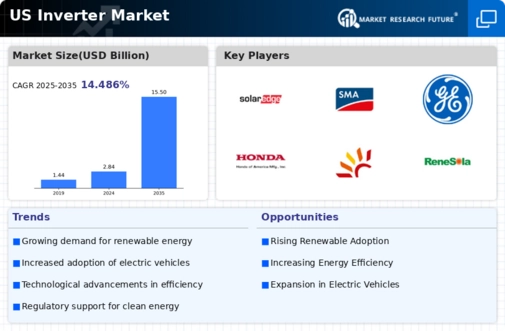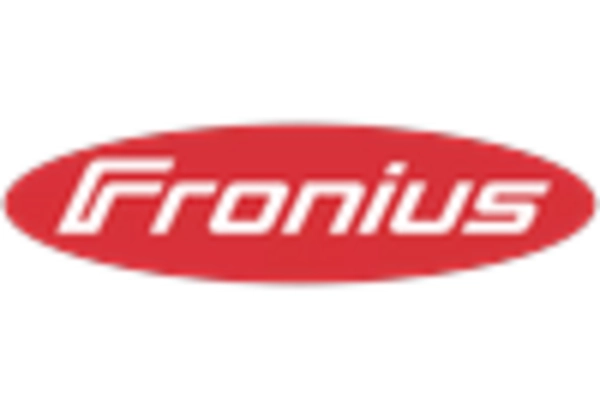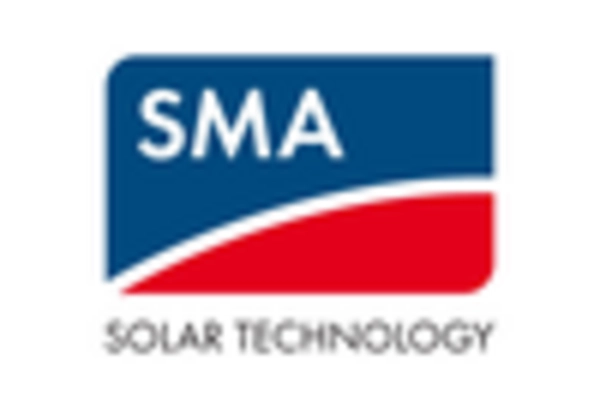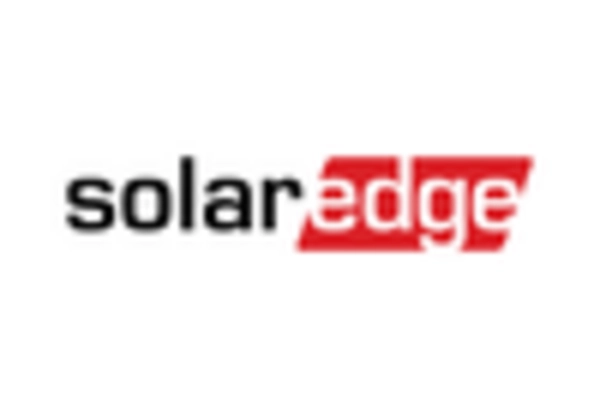Growing Adoption of Renewable Energy Sources
The inverter market is significantly influenced by the growing adoption of renewable energy sources across the US. As more consumers and businesses turn to solar and wind energy, the demand for inverters, which are essential for converting DC power to AC power, is expected to rise. In 2025, the solar energy sector alone is anticipated to account for over 40% of new electricity generation capacity in the US, necessitating a corresponding increase in inverter installations. This shift towards cleaner energy not only supports environmental goals but also aligns with federal and state initiatives aimed at reducing carbon emissions. Consequently, the inverter market is poised for substantial growth as it adapts to the evolving energy landscape.
Increased Investment in Energy Infrastructure
The inverter market is benefiting from increased investment in energy infrastructure throughout the US. Government initiatives and private sector investments are focusing on modernizing the electrical grid and enhancing energy efficiency. In 2025, it is estimated that investments in energy infrastructure will exceed $100 billion, with a significant portion allocated to upgrading inverter technology. This modernization is crucial for accommodating the growing influx of renewable energy sources and improving grid resilience. As utilities and energy providers seek to enhance their operational capabilities, the demand for advanced inverters is likely to rise, thereby propelling the inverter market forward. This trend indicates a strong alignment between infrastructure development and market growth.
Technological Advancements in Inverter Design
The inverter market is experiencing a surge in technological advancements, particularly in the design and functionality of inverters. Innovations such as smart inverters, which enhance grid stability and energy management, are becoming increasingly prevalent. These devices are capable of integrating with renewable energy sources, thereby improving efficiency and reliability. The market for smart inverters alone is projected to reach approximately $5 billion by 2026, indicating a robust growth trajectory. Furthermore, advancements in power electronics and digital controls are enabling inverters to operate more efficiently, which is crucial for meeting the growing energy demands in the US. As these technologies evolve, they are likely to drive the inverter market forward, creating new opportunities for manufacturers and consumers alike.
Supportive Regulatory Environment for Clean Energy
The inverter market is positively impacted by a supportive regulatory environment that encourages the adoption of clean energy technologies. Federal and state policies are increasingly promoting the use of renewable energy sources, which in turn drives the demand for inverters. Incentives such as tax credits and rebates for solar installations are making it more financially viable for consumers to invest in inverter technology. In 2025, it is projected that regulatory frameworks will continue to evolve, further supporting the growth of the inverter market. This favorable environment not only stimulates market growth but also fosters innovation as companies seek to comply with new regulations and capitalize on emerging opportunities.
Rising Consumer Awareness and Demand for Energy Efficiency
The inverter market is also being driven by rising consumer awareness regarding energy efficiency and sustainability. As individuals and businesses become more conscious of their energy consumption, there is a growing demand for technologies that can optimize energy use. In 2025, surveys indicate that over 60% of consumers are willing to invest in energy-efficient solutions, including inverters, to reduce their utility bills and carbon footprint. This shift in consumer behavior is prompting manufacturers to innovate and offer more efficient inverter solutions. Consequently, the inverter market is likely to expand as it caters to the increasing demand for energy-efficient products that align with consumer values.

















Leave a Comment